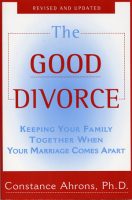What’s a Good Divorce?
A “good divorce” takes into consideration the needs and wants of all family members. Dr. Ahrons’ bestselling book, “The Good Divorce,” was based on her landmark study of family relationships after divorce. This groundbreaking research was the first of its kind to diverge from a pathological view of divorce and to study “normal” divorced families.
During the initial stages of her study, Connie developed the concept of binuclear family, a term she coined to describe any family that spans two households. Nuclear families have one nucleus – one shared household – whereas a binuclear family is split into two nuclei, each headed by one parent. A family continues to be kin even though it shifts from one nuclear family to a two-household binuclear family.
Connie’s Binuclear Family Co-Parenting Typologies are widely used by mental health professionals and families alike to illuminate co-parenting characteristics, challenges and to negotiate from crisis to restructuring in the family’s best interests.
Dr. Ahrons’ concepts of a “good divorce” and “binuclear family” have been popularized and replace stigmatizing pejoratives like “broken home.”
Excerpt from the book, The Good Divorce
The Good Divorce Is Not an Oxymoron
When I tell people the title of this book I usually get one of two distinct reactions. Either I hear a knee-jerk response, an incredulous: “Isn’t saying ‘good divorce’ a contradiction in terms, like saying ‘sweet sorrow’ or ‘cruel kindness’?” The other set of people–increasing in numbers lately–say, “It’s about time. Finally. We’re tired of hearing only about the horrors of divorce. We need models to help us do what we want–and need–to be able to do.” These listeners invariably have a story about someone they know (it might even be themselves) who fits the definition of the binuclear family. They’d just never put a name to it. They go on to describe some family with this strange relationship where they and their new spouses and all their respective kin spend Thanksgiving or some such holiday together–and everyone seems content.The good divorce is not an oxymoron. A good divorce is one in which both the adults and children emerge at least as emotionally well as they were before the divorce. Because we have been so inundated with negative stories, divorce immediately carries with it a negative association. Even though we have difficulty conjuring up positive images of divorce, the reality is that most people feel their lives improved after their divorces.
In a good divorce, a family with children remains a family. The family undergoes dramatic and unsettling changes in structure and size, but its functions remain the same. The parents–as they did when they were married–continue to be responsible for the emotional, economic, and physical needs of their children. The basic foundation is that ex-spouses develop a parenting partnership, one that is sufficiently cooperative to permit the bonds of kinship–with and through their children–to continue.
If people are going to divorce and remarry (and even redivorce) in droves, as by all predictions they are, then structuring a good divorce process, family by family, has become absolutely essential. Our sanctioning the process must be incorporated into our dreams of the good life, not treated as the root cause of all of our social nightmares.

